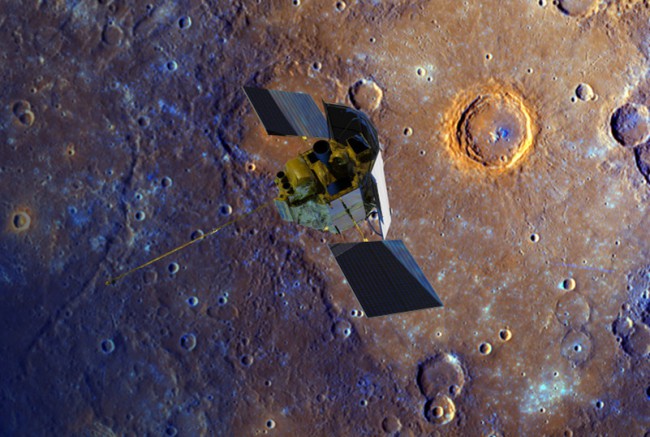The MESSENGER spacecraft depicted flying over Mercury's surface. NASA/Johns Hopkins University Applied Physics Laboratory/Carnegie Institution of Washington
The MESSENGER team initiated the “hover” observation campaign, which was designed to gather data from the planet at ultra-low altitudes until the last possible moment.
By Johns Hopkins University Applied Physics Lab, Laurel, Maryland | Published: Thursday, March 19, 2015
MESSENGER will not go gentle into that good night. The mission will end sometime this spring when the spacecraft runs out of propellant and the force of solar gravity causes it to impact the surface of Mercury. But the team initiated a “hover” observation campaign designed to gather scientific data from the planet at ultra-low altitudes until the last possible moment. Engineers have devised a series of orbit-correction maneuvers (OCMs) over the next five weeks — the first of which was carried out today — designed to delay the inevitable impact a bit longer.
A highly accurate OCM executed on January 21 targeting a 9-mile (15 kilometers) periapsis altitude — the lowest to date — set the stage for the hover campaign in a short extension of the Second Extended Mission termed XM2-Prime (XM2’). The top science goals for XM2’ will be carried out with the Magnetometer (MAG) and the Neutron Spectrometer (NS), and each instrument will target different objectives in different regions, said Haje Korth of The Johns Hopkins University Applied Physics Laboratory (APL) in Laurel, Maryland.
“With MAG, we will look for crustal magnetic anomalies,” he said. “For instance, we have seen hints of crustal magnetization at higher altitudes — ~40 miles (70km) — over the northern rise in Mercury’s northern smooth plains. We will revisit this region at lower altitudes during XM2’. There may be other regions where such signals can be observed, and we will be looking for them.”
“With NS, scientists will hone in on shadowed craters at northern high latitudes to search for water ice,” Korth said. “We have found such evidence previously in the mission, but we hope to find more at low altitudes and spatially resolve the distribution within individual craters if we are lucky.”
According to Korth, the observations enabled by this “saving throw” are no less significant than earlier ones. “Establishing the presence of crustal magnetic anomalies on Mercury would be a huge result because it would extend the known temporal baseline for Mercury’s internal magnetic field by eight orders of magnitude,” he said. “Moreover, observing any such anomalies at different altitudes will allow the depth of the source to be determined.”
“Since the periapsis altitude during the hover campaign is ~20 miles (30km) or less throughout XM2,’ we will have the opportunity to map half the planet with a magnetic magnifying glass, so to speak,” Korth said. “There are regions we have never seen at such low altitudes and multiple areas of magnetic anomalies may be detected.”

